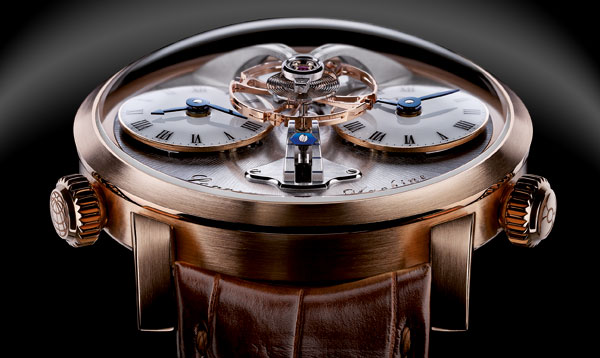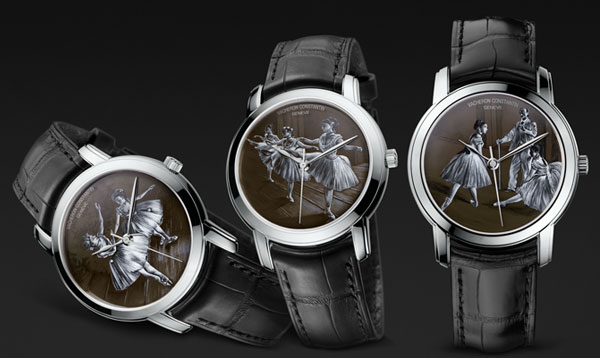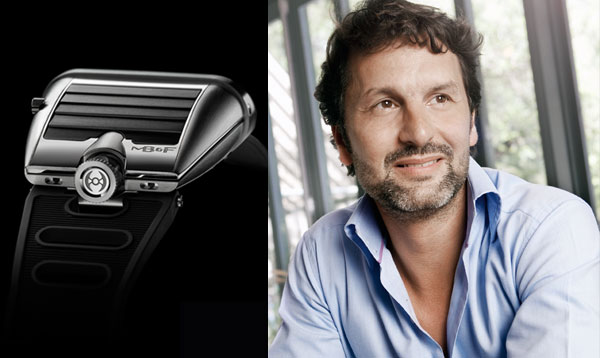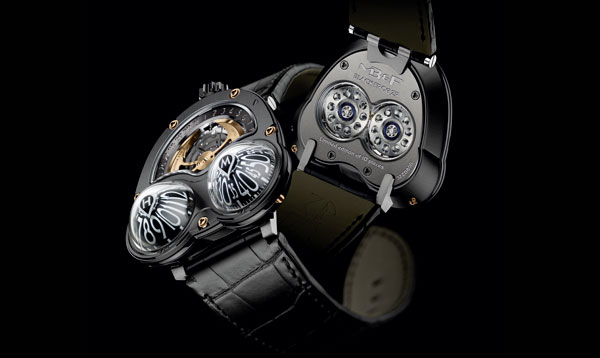
Horological Machine No1
An innovative and completely original timepiece, Horological Machine N°1 features the world’s first movement with four barrels connected in both parallel and series as well as the first wristwatch movement to have energy simultaneously transmitted to the regulating system from two sources. The anatomy of HM1 is a poetic fusion of architecture and horology. Two discrete dials, one for hours, the other for minutes are joined by an elevated central 60-second tourbillon that creates its own centre stage. Within the 18k gold case beats a movement like no other : 376 parts, 81 functional jewels, together with the four massive mainspring barrels. Wound automatically, the lungs of this machine breathe life into the Machine, endowing HM1 with an impressive 7-day power reserve.
Horological Machine No2
With its distinctive rectangular shape, flying buttresses, dual portholes and modular construction, Horological Machine N°2 startled the world of haute horlogerie when it was launched in 2008. HM2-SV then surprised again with its crystal-clear sapphire case offering unprecedented visual access into the meticulously hand-finished, 349-component engine powering the indications on HM2’s iconic twin dials.
HOROLOGICAL MACHINE N°3
After the shock of HM1 and otherworldly HM2, Horological Machine N°3 hammered home the message that MB&F was in an alternate reality when it came to fine watchmaking as contemporary art. The press release for HM3 began : “Warning ! Horological Machine N°3 is so far outside existing timekeeping references that it may cause sensory overload.” It might have also warned those with a weak heart or a preference for the comfort of traditional timekeepers to stay close to a defibrillator and medical assistance. HM3 is available in two versions, each offering its own very distinct visual characteristics : ‘Sidewinder’, with the indicator cones lined perpendicular to the arm ; and ‘Starcruiser’, with cones in line with the arm. At first regard the viewer’s mind attempts to take in HM3’s kinetically energetic movement and reconcile the paradox of the automatic winding rotor on the top of the watch, before being assailed again by twin cones rising majestically from the sculptured three-dimensional case. No wonder so many struggle to comprehend that this dynamic three dimensional sculptural art is also a highly technical wristwatch. With both winding rotor and oscillating balance on top of the Machine’s engine to better appreciate its beautiful finishing, HM3 pushes both the technical and aesthetic limits of horological architecture and design further than anyone could imagine… and then some! Two high-tech ceramic bearings drive the time indications in the cones: one showing hours plus day/night, the other the minutes, while an oversized date wheel around the rotor – incredibly it is a larger diameter than the movement itself – frames the engine. The prominence of the battle-axe 22K solid gold rotor on top of HM3 increases recognition of this already iconic MB&F symbol.
HM3 Frog
One of MB&F’s main goals is to bring a child’s sense of awe and playfulness into high-end watchmaking. With the HM3 Frog series, that goal has undoubtedly been achieved. The protruding eyes of real-life frogs enable them to see in many directions without having to turn their head. HM3 Frog’s bulbous hour and minute domes – paper thin and meticulously honed from solid blocks of aluminium – create a similar, but reversed, effect in that the wearer can easily read the time from a variety of angles without having to turn their wrist. The original HM3 Frog Ti is named after its high-tech titanium case. Its blue 22k gold battle-axe winding rotor on top of the Jean-Marc Wiederrecht designed complication is framed by an oversized date wheel. The Frog may portray the time in a playful manner, but there is nothing but meticulous attention to detail regarding the fine hand-finishing of the highly-tuned engine.
HM3 Poison Dart Frog
HM3 Poison Dart Frog is a limited edition of 10 pieces inspired by the spectacular yellow-banded poison dart frog hailing from South America. The deadly potential of these innocuous-looking amphibians is camouflaged in the tropical rainforest by their exotically-patterned black and yellow skin. Similarly, the high-tech zirconium case of Poison Dart Frog is disguised by a sleek, black layer of PVD contrasting spectacularly with the animated yellow gold rotor and screws.
HM3 Fire Frog
HM3 Fire Frog is a limited edition of 10 pieces created exclusively to celebrate the opening of the MB&F boutique in Beijing. Fire Frog is named for the warm glow emitted by the 18k red gold of its complex case and 22k red gold winding rotor. Rising up from the fire are the iconic bulbous domes of the Frog’s hour and minute indicators. With its regal red gold case, HM3 Fire Frog warms both heart and eye.
Horological Machine No4 ‘Thunderbolt’
The streamlined faster-than-sound looking HM4 Thunderbolt stretches horological art to its very limits. Neither the Thunderbolt’s aviation-inspired case or engine would or could exist without the other, yet each is so transcendental as to be able to stand alone as a work of art in its own right. The case of HM4 blends high-tech titanium for its lightweight and strength with a sapphire crystal centre section offering a stunning view into the Engine. The limited editions HM4 Razzle Dazzle and Double Trouble take the aviation theme even further with real hand-applied rivets in their fuselages and hand painted ‘nose art’ inspired by the rebellious paintings on WWII aircraft. The exclusive HM4 RT, with sophisticated satin-sheen red gold and sapphire case, offers an altogether more luxurious way to fly.
The Thunderbolt’s engine is the culmination of three long years of intensive development. Each of the 300-plus components – including the regulator and even the screws – was developed specifically for this anarchistic calibre. Horizontally configured dual mainspring barrels drive two vertical gear trains, transferring power to the twin pods indicating hours/minutes (right) and power reserve (left). With the dials perpendicular to the wearer’s wrist, Horological Machine N°4 might be described as the perfect pilot or driver’s watch. Each of the two aviation instrument-styled dials – one to wind and re-fuel the tanks, the other to set the time – is directly controlled by its own crown, providing instantaneous feedback of the action. Visible through a shaped sapphire display panel on the top of the case, a distinctive streamlined cock supports the balance, its centre cut away to reveal as much of the oscillating wheel as possible and validating the “kinetic” in MB&F’s “kinetic art”.
Horological Machine No5 ‘On the Road Again’
The unmistakable wedge-shaped case of HM5 ‘On the Road Again’ is direct homage to the plucky Amida Digitrend watch from the 1970s; however, it also has unmistakable references to another icon of that era, the Lamborghini Miura, the original supercar. While the Miura revolutionised car design in a plethora of ways, one of its many striking features were the black louvres over the back window. The last decade or two has seen an exponential growth in inventions that have revolutionised our lives. Robots may not yet cook dinner, but they do build cars, vacuum the home and mow the lawn. Sending a man to Mars is more a question of economics than engineering. But imagine the excitement and dreams of the future in the early 1970s. Man could fly on the road with Italian supercars; fly on the sea with hovercrafts; fly at supersonic speeds on Concorde; and fly to the moon in Apollo. Everything was possible, including humanoid robots, jet-packs and flying cars. In the 1970s, the future wasn’t tomorrow, it was today! At first glance HM5 ‘On the Road Again’ appears to be a relatively simple timepiece. But it’s much more complicated than that. The time display consists of bi-directional jumping hours and minutes with indications inversed, reflected 90° and then magnified 20%. HM5’s case is not water resistant, but its movement is. Rear louvres on a supercar block light, on HM5 they let light in. HM5 has exhaust pipes, but they drain water. HM5 is called ‘On the Road Again’, but its inspiration, the Digitrend, barely left the garage.
The hour and minute time displays are overlapping numbered disks rotating horizontally on top of the movement, yet the time is displayed vertically in a ‘dashboard’ at the front of the case. For this MB&F worked with a high-precision optical glass supplier to develop a reflective sapphire crystal prism that would both bend the light from the disks 90° as well as magnify it by 20% to maximise legibility. The vertical forward-facing display makes HM5 ‘On the Road Again’ an excellent driver’s watch: there is no need to lift the wrist from the steering wheel of your Lambo to read the time! As with any supercar, the best often lies under the hood and looking below the surface of the HM5 case reveals a surprise : another case ! The reason for the inner container is water resistance. Those supercar louvres on HM5 let in light, but also water – the reason for those dual exhaust ports – so to protect the high-performance Engine from moisture as well as shocks, it is housed in its own stainless steel shell. This inner case is similar to the ridged chassis of a car on which the external coachwork/body is mounted. Turning HM5 over reveals the Engine through a sapphire crystal display back with its 22k gold battle-axe winding rotor, fast oscillating balance and stunning hand-finished bridges.
Legacy Machine No1
Until 2011, MB&F’s futuristic Machines might be accurately described as ‘wild’, ‘extreme’, ‘unrestrained’ and even ‘outrageous’. Words like ‘traditional’, ‘classical’ and ‘round’ did not appear in the MB&F lexicon. However, that all changed with Legacy Machine N°1 (LM1). With its monumental central balance ; superlatively finished movement ; completely independent dual time zones ; world-first vertical power reserve indicator and elegant annular case, LM1 is a sublimation of classical excellence ; a joyful celebration of traditional watchmaking; and, above all, an authentic three-dimensional MB&F Machine. Legacy Machine N°1 was conceived when Maximilian Büsser started imagining : “What type of Machines would I have created if I had been born in 1867 instead of 1967 ? In the early 1900s the first wristwatches appear and I would want to create three-dimensional Machines for the wrist. But there are no Grendizers, Star Wars or supersonic jets for my inspiration. However, there are pocket watches, the Eiffel Tower and Jules Verne, so what might my 1911 Machine look like ? It has to be round and it has to be three-dimensional : Legacy Machine N°1 was my answer.” In fidelity to high-quality 19th century pocket watches, LM1 features a traditionally slow oscillating (2.5 Hz), large diameter balance with Breguet overcoil suspended from majestic twin arches. Its enigmatic regulating mechanism is in full view, but without apparent connection to the movement. Both the hours and the minutes on each of the two sub dials can be set completely independently of each other (dual time zone complications usually do not allow independent adjustment of the minutes), the pristine white dials further reinforcing visual references to that golden age of watchmaking, 1780-1850. Looking like a miniature sextant, the world’s first wristwatch vertical power reserve indicator keeps track of available power and provides a visual three-dimensional counterpoint to the graceful arches supporting the balance. Gazing down through Legacy Machine N°1’s crystal clear bubble dome to the micro-mechanical fantasy below, it’s easy to imagine Jules Verne’s Captain Nemo gazing down upon the mythical underwater city of Atlantis.
Legacy Machine N°1’s in-house movement bears testimony to the enormous talent of its creators, Mojon and Voutilainen. Jean-François Mojon and his team at Chronode (Best Watchmaker Prize at the 2010 Grand Prix d’Horlogerie de Genève) met the considerable challenge of developing the movement for LM1 from a blank sheet, while acclaimed independent watchmaker Kari Voutilainen took responsibility for the aesthetic design and ensuring the utmost respect for tradition and finish. Immaculate Geneva waves, highly polished gold chatons and bridges with impeccably executed bevels following deliberate internal angles (which cannot be finished by machine), showcase the absolutely peerless fine-finishing. The movement of Legacy Machine N°1 proudly bears the names of both its creators and is the first calibre (other than his own) to bear Voutilainen’s name. Available in either white gold or red gold, with Legacy Machine N°1 MB&F has reinterpreted traditional 19th century watchmaking excellence to create a contemporary horological objet d’art.








